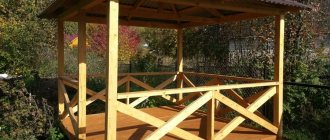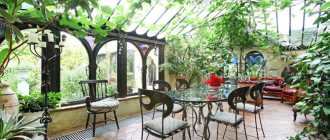Acquaintance
The word "rabatka" has German roots. Translated, this means “narrow flower bed.” This landscape element first began to be used in the Middle Ages. They decorated courtyards and used them as pharmacist's beds.
Today, a rabatka is understood as an elongated flower bed in the shape of a rectangle, laid out near paths and vertical structures. The optimal ratio is 1 to 3. In reality, such proportions are not always followed.
The numbers indicate rows of plants. According to the rules, such a flowerbed, if it is small, consists of three rows. The maximum number of rows is five. The length of such a flower bed can reach up to 20 m. The width cannot exceed 3 m.
The photo of the ridge shows that the plantings in it are made according to a certain pattern, creating a beautiful pattern. A special feature is the ability to maintain decorative properties for a long time.
What is a discount
The long narrow planting of flowers in Russia was originally called the German garden bed. Then the name, coming from a German (rabatte) or Dutch (rabat) root, stuck. The term was used in the 18th century by European tailors, for whom it meant the cuff of a frock coat.
In modern urban landscape design, a flower garden is understood as a rectangular flower garden, in which the width is tied to the length with a minimum ratio of 1:3. Rabatka is a type of flower garden in landscape design that has the following properties:
- The width of classic urban ridges ranges from 0.5 to 3 m, the length is arbitrary. That is, if a width of 0.5 m is laid, then the length must be at least 1.5 m; There are no restrictions on the maximum length.
- They are placed along paths and walls, along the edges of terraces and platforms, around gazebos.
- The number of plant species is small and is usually limited to 1-3 varieties.
- Flowers are planted in rows: the shortest in the foreground, the tallest in the background.
On a grand scale Source www.aljanh.net
Initially, discounts were not only decoration. In French royal gardens, they helped delimit open space and create its pattern and rhythm. A ridge should be distinguished from a border, which serves only to frame, most often lawns, flower beds and paths. The border is not so wide - no more than 0.5 m, not so high and less diverse in composition.
Sometimes a rabatka is confused with a mixborder - a flower garden in which plants are arranged randomly, although they are selected taking into account the size and timing of flowering. Mixborder is a sign of landscape style; it does not have clear lines, and the number of colors is limited only by the designer’s imagination.
In front of the house Source st.hzcdn.com
See also: Catalog of companies that specialize in designing and performing landscape work of any complexity
Difference from mixborder
Many gardeners confuse these two types of flower beds. Let's try to figure out what the difference is. The differences are as follows:
- Rabatka is characterized by a more strict appearance and the presence of clear lines.
- Unlike a mixborder, this is an element of a regular style.
- The discount appeared much earlier. Even in the medieval era, it was used to decorate gardens belonging to the nobility.
- Mixborders are easier to care for.
First experience in creating a discount
Beginning flower growers can create their first garden with several easy-to-care plants of approximately the same habit. They can be arranged in longitudinal stripes, just like vegetables are planted in a garden bed. In this case, the flowering dates in the rows should alternate - this will create the appearance of continuity of flowering in the flower bed.
If you need to create a more complex ridge, you should start with a sketch. On a sheet of paper, the planting sites of each species are marked in different colors, taking into account the ratio of the height of adult plants.
When the plan is drawn up, the boundaries of the flowerbed are marked on the site, the soil is prepared for planting seedlings, and as soon as the time comes, they are planted.
Practical recommendations for beginners:
- There is no need to try to fill the entire flowerbed with perennials at once. Bright annuals are planted in the voids between the main species, which free up space at the end of the growing season. This will provide an opportunity to make adjustments and correct errors over time;
- Variegated perennials will add color to the flowerbed: hostas, euonymus and others. They compensate for the lack of colors that arose in the periods between waves of flowering;
- It should be noted that an adult plant takes up more space than seedlings, so there is no need to skimp on soil;
- The flowerbed will bloom earlier if you use primroses (hellebore, primrose) and bulbous flowers in its design. They will bloom even before the perennials wake up, thanks to which the ridge will not be empty in the early days.
One-sided
Externally, this is a classic flower bed, planted along a wall or fence. You can only approach it from one side.
Plants are planted in a certain order from large to small. The foreground is occupied by low species, the background by tall species, and between them there is medium-sized vegetation.
Speaking about the one-sided type ridge scheme, the use of both perennials and annuals is allowed.
The use of annual crops will make the flower garden more picturesque and colorful. In addition, this way you can change its appearance every year.
By choosing a flowerbed from perennials, you will make it easier to care for. In addition, such “beauty” will delight the eye for many years.
Procedure for creating a flower garden
Creating a discount yourself is not at all difficult. The main thing is to outline the procedure and strictly follow the plan.
What cacti can you put on your windowsill?Garden chairs
How to plant and grow an oak tree from an acorn at home
Approximate sequence of steps:
- Choosing a location and shape for a flower garden.
- Assessment of climatic conditions and selection of vegetation.
- Developing a flower planting plan.
- Soil preparation.
- Planting plants according to plan.
- Decoration of edges.
Consider the fact that planting flowers can occur either in beds or in intricate patterns.
The geometric parameters of the ridge depend on the wishes and preferences of the land owners, as well as on the availability of the territory.If the flower garden is very long, to diversify it, you can plant some aesthetically attractive single plant at regular intervals or create small flower beds.
Double-sided
There is access from 4 sides. Placement: the central part of a wide path, a dividing strip on a highway. At the dacha, it is laid out as far as possible from buildings.
Evergreens - a complete list with descriptions and recommendations from a gardenerVertical gardening - from idea to implementation, choosing options according to budget and attractiveness (photo + video)
- Vertical flower beds - basic principles and rules for choosing plants and arranging a suburban area with your own hands
As for the design, tall plantings are carried out in the center. Then medium-sized plants are introduced, and finally low ground covers are planted.
It is appropriate to equip double-sided flower beds not only on a leveled area, but also on an artificially made embankment. The second option is usually used if you want to create a wide border.
Symmetrical
This is the most traditional (and complex) type of flower bed, since the flowers in it are planted in the form of a regular rectangle: the width does not change throughout the entire flower bed. The classic “German bed” has two sides and is most often formed from annuals that bloom all season.
The tiered design is strictly observed, and the patterns are repeated, forming picturesque geometric patterns. Often, the central part of the site is decorated with a symmetrical ridge: for example, placing it between two straight paths.
Asymmetrical
Key Features:
- chaotic arrangement of plants;
- placement along buildings, fences and sculptural compositions;
- the shape is either clear, consisting of straight segments, or smooth, with an abundance of winding lines;
- more natural and aesthetic appearance.
In some cases, plants are planted in groups, with low varieties surrounding tall varieties.
It is allowed for an asymmetrical flower bed to partially or completely surround the building.
Decorative grass - 140 photos of original design. Review of the best varieties of grass for the garden, instructions, reviews, videos + gardener recommendationsWatering the site - types and types of systems, main differences and features, rules for selection and installation, as well as recommendations for operation
Ornamental plants - 140 photo options. Review of the most popular plants with names and descriptions. Gardener's recommendations + reviews
Carpet
In such a flower garden, low-growing forget-me-nots, allisum, pansies, and ground cover plants look good. If you dream of a long-blooming flowering plant, give preference to annuals or combine them with perennials. Lobelia, viola, and ornamental cabbage are suitable. Petunias, nasturtiums and marigolds will delight you with long flowering.
Intermittent
This kind of dacha in the country is very long. It is appropriate to divide it into sectors. You can use the following as delimiters:
- tall, usually perennial, vegetation;
- shrub forms;
- flower beds of a different configuration.
Landscape designers advise interrupting the ridge in sections ranging from 5 m to 15 m. In fact, the interruption location is selected in random order, taking into account the characteristics of the design and environment.
How to correctly design the border of a discount?
The ridge looks much more interesting if it has strictly defined boundaries, which can be arranged using:
- low fence;
- curbstone;
- filling of decorative materials (sawdust, marble chips, fine gravel);
- tile.
Thoughtful arrangement of the borders of the flower bed will provide an exclusive look and finished forms of the flower bed.
This may take a lot of time, but there is no need to rush, since the 2-3 weeks spent will then pay off many times over with the delight of your guests.
Other classification
According to the number of tiers, ridges are divided into:
- Single-tier. All “filling” has the same height.
- Two-tier. Accordingly, plants of 2 different heights are planted here.
- Multi-tiered. An assortment of plantings of varying heights.
The flower garden design can be:
- floral;
- carpet;
- ornamental.
According to the number and type of plants used, ridges are distinguished:
Boxwood: planting, care, growing in open ground, propagation. Full description of the plant from A to Z. More than 100 photos of evergreen shrubsLiving fence - the best ideas on what to make a hedge from at your summer cottage. Many photos of ready-made options with exclusive designs + instructions
- Trimming bushes - the basics of choosing the right plants and forming the right shapes, selecting tools (photo + video)
- one-component;
- multicomponent;
- annuals;
- perennial;
- combined.
Depending on the color design, this type of flower bed is divided into:
- Single color. The optimal solution for small, narrow flower beds.
- Two-color. The two colors used can be either contrasting or similar in color palette.
- Multicolor. Characterized by the use of more than 2 shade combinations.
- Monochrome. Flowers are planted, the flowers of which are in the same color scheme.
One-component
The listed types of flower beds are usually formed from 2–4 types of plants, resulting in a multi-component flower garden of several tiers. But there are beds in which only one type of plant is used - and they look no less colorful than flowerbeds of different varieties.
One-component flower beds are created by planting flowers of various varieties and shades (tulips, roses, daffodils, marigolds, etc.). The only disadvantage of some of them is the short flowering period.
Adviсe
Below are recommendations that you should follow if you want to organize a garden plot with your own hands:
- The place for the flower garden should be level.
- The composition must be in harmony with the general style of the territory.
- The ideal background would be conifers.
- The choice of plants should take into account the climate of your area and the type of soil.
- Try to plant plantings so that some do not shade others.
- Take the time to calculate the flowering time for each selected plant.
- Adhere to the following planting density - 18 sprouts per 1 m², of which 50% are low-growing plants, the other 50% are medium- and tall-growing specimens.
- Try to avoid any gaps.
Flowerbed planning
It is recommended to decorate a long ridge with small flower beds
Any design decision requires planning. It is recommended to sketch the design schematically on paper in color to visualize the object. They immediately identify the dominant colors. You can create a bright contrast (for example, blue with yellow or orange) or a calm tone (for example, alternating gray foliage with white or pink flowers). In flower gardens it is permissible to group both annual and perennial plants. You can combine several types of different colors, but do not overdo it with the quantity. Otherwise, the flowerbed will look too colorful. It is more rational to take single-species plants of different varieties. Then it will be easier to care for such a flower garden.
Calculate the width of the ridge based on the area of the site. In a small garden, it is optimal to create a flower bed no more than half a meter wide. There are also certain rules for planting density: per 1 sq. m of territory - 8–9 low-growing or 5 medium and 4 tall varieties. In order for a continuous carpet to form during flowering, the buds of the planted representatives must be large.
When installing a ridge of five meters or more in length, it is recommended to make breaks every 5 m, which are decorated with compact flower beds.
The sequence of steps for arranging a ridge
Once everything is planned (location, assortment, design), you can begin the breakdown. Prepare:
- shovel;
- rake;
- watering can;
- priming.
Procedure:
- Transfer the plan to the area. Mark the boundaries with pegs and rope.
- Remove the top 15 cm of soil. Place border material around the edges.
- Fill in the prepared soil.
- Plant flowers according to the chosen scheme.
- Water thoroughly.
Nuances of care
In order for the flower garden to please you, it is necessary to carry out the following activities on a regular basis:
- watering;
- weeding;
- application of fertilizers.
Before winter, you need to remove all annual plantings and inspect perennials for diseases and pruning. To protect from the cold, the flowerbed must be tightly covered.
Selection of plants
Workers welcome the following “filling”:
- dwarf varieties of conifers (spruce, thuja, juniper);
- asters, marigolds;
- daffodils, lilies or lupins.
Compositions made from chrysanthemums and yarrows look beautiful. Using tulips and irises is a good idea.
Do you want something more daring? Plant vegetables and herbs. The main thing to remember is that the colors of plants must be harmonious. And to structure the composition, it is best to use conifers, spices and grains.
To summarize, we note that there are a lot of variations of discounts. Therefore, it will not be difficult for you to choose the solution that is right for you.
How to create a discount with your own hands and choose plants
The ridge allows you to play with country houses in an original way, set the desired direction, and, if necessary, extend or, conversely, expand the site. It can divide a vegetable garden or garden into zones or greet guests at the very entrance. To make the flower garden aesthetically correct, I will give you some important tips on how to make it and choose plants.
Tips for creating your own discounts
- If the width of the ridge is up to 50 cm, plant the plants in 2 rows. With a width of 1 to 1.2 m - in 3 rows. Consider the habit (size) of the plant and how it will grow over time.
- When planting, cover the entire area with plants so that no soil is visible between them. It looks very sloppy and is not exciting.
- Try not to create colorful flower beds. In most cases, they look tacky and disrupt the overall appearance of the composition. Choose calm, close tones or use 2 – 3 bright tones.
- Plant plants in strips or islands. They look very attractive and set the rhythm of the composition.
- Maintain planting density. No more than 18 plants can be planted per 1 m² - 4 tall, 5 medium-sized and up to 9 low-growing.
- The edges of the ridge do not have to be left smooth; they can be rounded or made into a recess.
___________________________________________________________________
WORKS AT THE DACHA: TYPES AND DESIGN
How to make a discount with your own hands
| 1. Create a garden scheme and select plants |
We create a diagram on paper or electronically - a sketch of the future flower garden to scale.
- We select plants and decide on size and location.
- When selecting plants, color is fundamental, and then only the growing conditions and their characteristics.
- Then the location, composition and moisture of the soil, lighting, and wind load are taken into account.
- First choose the “solo” plants that will attract the eye, and then the secondary ones.
- The last to appear on the diagram are ground cover plants that cover the space between the main plantings.
Options for successful color combinations:
- blue, yellow and white
- dark purple, shades of lilac and yellow
- red and white
- white and green
| 2. Consider the design of the border of the flower garden |
The boundary for a discount can be:
- curbstone,
- border tape,
- low fence,
- paving slabs,
- backfill of gravel or marble chips.
With proper design of the borders of the ridge, a neat appearance and completeness are guaranteed. All this can take from 1 to 2 weeks. Don’t rush, give time for the “birth” of the flower garden.
| 3. Prepare a place for a discount |
- The ground for planting should be cleared of weeds, dug up with a shovel, and fertilized if necessary.
- Mark the boundaries of the future flower garden using pegs, pegs and twine, spray, or simply draw a line with a shovel or something sharp.
| 4. Plant the plants |
- It is best to plant plants in the spring, after the onset of warm weather.
| 5. Mulch the soil |
- It is advisable to mulch the soil between planted plants; this will save your time on weeding, watering and loosening.
- You can use any mulch, from the simplest cut, dried grass to pine chips and gravel.
| 6. Take care of your flower garden |
- Remove weeds periodically throughout the season, water, fertilize, and add mulch as needed.
- In the fall, collect seeds from annual plants and remove them from the flower garden, and prepare perennials for wintering.
Tips for selecting plants for gardening
- Try not to use many varieties of plants. Rabatka is not a mixborder; it is simple and not fancy. The optimal number of plants is from 1 to 6.
- Select unpretentious and hardy plant species.
- Select plants with different flowering periods so that your flower garden looks elegant at any time of the season.
- Using one type of plant, experiment with different color combinations and create a unique mood and atmosphere.
- Use decorative deciduous plants that will keep the flower garden looking “elegant” all season long.
- A ridge planted only with coniferous plants looks beautiful.
- If you are using beautifully flowering plants without beautiful foliage, then line the bottom of such plants with decorative foliage, they will create the necessary background.
Plants for gardening
| Tall perennial plants |
- echinacea,
- delphinium,
- rudbeckia,
- lupine,
- mallow,
- phlox,
- peony,
- chrysanthemum,
- fern,
- digitalis,
- medium bell,
- helenium,
- autumn aster,
- jagged buzulnik, etc.
| Low and medium-growing perennial plants |
- hosta,
- fescue (all its types),
- maned barley,
- heuchera and heucherella,
- dicentra,
- low growing iris,
- evening primrose,
- Brunner,
- low growing daylily,
- astilbe,
- primrose,
- rose,
- various types of cloves,
- sedums,
- saxifrage,
- chamomile,
- daisy,
- Carpathian bell,
- lavender,
- gravilate, etc.
| Low and medium-growing annual plants |
- marigold,
- viola,
- lobelia,
- petunia,
- nemophylla,
- Iberis,
- decorative cabbage,
- nasturtium,
- calendula (marigold),
- allisum,
- dahlias,
- pelargonium,
- cineraria,
- canna,
- coleus,
- kohia,
- zinnia,
- cosmos, etc.
| Bulbous plants |
- tulips,
- crocuses,
- muscari,
- daffodils,
- hyacinths,
- hippeastrum,
- hazel grouse,
- snowdrops (galanthus),
- different types of bows,
- decorative garlic,
- gladioli,
- scilla,
- lily,
- freesia, etc.
| Spicy aromatic herbs |
- thyme,
- mint,
- Melissa,
- hyssop,
- sage,
- yarrow,
- catnip,
- anise lofant,
- Swiss chard,
- physalis, etc.
| Decorative deciduous perennial shrubs |
Boxwood barberry (height 0.5 m),
- Japanese maple,
- dwarf spirea,
- weigela, etc.
| Tall coniferous plants |
- thuja,
- junipers,
- ate,
- pine trees, etc.
| Low and medium-growing coniferous plants |
- spherical thujas,
- ground cover and creeping junipers,
- dwarf pines, etc.
Registration of a discount
| Flowerbed of perennials |
1. When creating such a flower garden, keep in mind that perennial plants grow over time. When planting, leave a small distance between plants “for growth”, planting them with annual species in the first years, since perennials tend to bloom only 2–4 years after planting. 2. Select plants with different flowering periods - early spring, spring, summer and autumn. 3. Such a flower garden reaches its peak of decorativeness 4-5 years after planting. 4. We thin out plants no more than once every 3–4 years.
| Work along the paths |
1. By planting perennials along the paths, you will forget about these areas for many years and enjoy the beauty that grows every year. 2. You can plant in 1-2 rows or more. You can arrange the plants in a straight line, or in a checkerboard pattern. 3. You can divide the ridge into several zones, separating one from the other with some kind of accent plant, such as a rose, peony or shrub. ___________________________________________________________________
GARDEN PATH DESIGN ___________________________________________________________________
| Work along the fence |
1. In such a discount you can use decorative elements in the form of garden figurines, driftwood, stones and other garden “decorations”. 2. You can create a smooth transition from a riot of plants, for example, to a path or lawn, it looks very beautiful. 3. If the fence is translucent, then use plants with densely growing foliage or needles; over time they will grow and you will form a dense vertical carpet that will hide you from intrusive views.
| Rabatka in the shade |
1. Carefully select plants for such a corner. Plant there only those plants that will be comfortable in a shady place and moist soil.
Fortunately, there are many such plants, for example:
- hosts,
- astilbe,
- rogersia,
- ferns,
- forest anemone,
- lilies of the valley,
- various types of anemones,
- bergenia,
- periwinkle,
- Duchesnea indica,
- forest and mountain bells,
- bought,
- cuff, etc.
____________________________________________________________________
SHADOW-TOlerant FLOWERS _____________________________________________________________________
2. Flowers made from the same hostas, but of different types, look beautiful. 3. Your flower bed will look no less original if it is made from only ferns, of course, also of different types.
| Rabatka along the house |
1. Along the house you can plant various types of ridges, complex multi-component ones with a pattern and simple single-row ones made of perennials or perennials. 2. When choosing plants and designing an idea, proceed from the architectural style of your home and the overall design of the site. Try to make everything look harmonious and avoid disharmony.
| Flower of roses |
1. Here, too, there is room to roam, there are many types of roses, and by combining different types of roses, for example, ground cover and hybrid tea or floribunda, we will get such beauty and flowering from June to September. 2. A rose garden made in the form of a ridge will become even more impressive if a fountain or forged sculpture is placed at the end of it. 3. Polyanthus roses are suitable for small and narrow ridges. 4. It would be appropriate to place scrubs in a wide border. 5. If the roses are tall enough, then they can be supplemented with hostas at the bottom, hiding the ground with them and decorating the flower garden. ______________________________________________________________________________
CREATING A ROSARY IN THE GARDEN _______________________________________________________________________________
| Flower bed made of peonies |
1. If you plant only peonies in a garden, remember that they have a limited flowering time; at other times they decorate the space with their carved leaves. 2. Plant several types of peonies, for example, early flowering and late flowering, then your flower will dazzle you with its flowering for a much longer time. 3. Peonies can be lined from below with bright annuals or ground covers.
| Rabatka from annuals |
1. Such discounts look very bright, and every year they look new.
2. A flower bed of petunias of various colors, planted in some pattern or ornament, will bloom continuously all summer, starting from May and until late autumn, until frost sets in.











